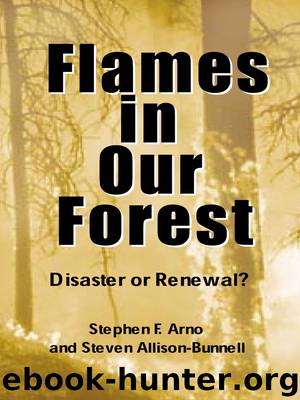Flames in Our Forest by Stephen F. Arno & Stephen Allison-Bunnell

Author:Stephen F. Arno & Stephen Allison-Bunnell [Arno, Stephen F.]
Language: eng
Format: epub
ISBN: 9781597266031
Publisher: Island Press
Published: 2013-03-21T16:00:00+00:00
Fire-Initiated Age Classes of Trees
When a fire heavily thins or kills a forest, a flush of new tree regeneration is likely to follow. You can identify such a cohort of same-aged trees as a fire-initiated age class even if it was first established centuries ago. These age classes of living trees are a testimony to fires of the past. They are most evident in mixed and stand-replacement fire regimes, where fires were infrequent and created room for new trees. The pioneer tree species require open conditions to regenerate in large numbers. Thus, “even-aged” stands of these species (including lodgepole pine, western larch, and coastal Douglas-fir) occur after major disturbances like fire, severe blowdowns, insect epidemics, or heavy logging. The new trees initially grow fast on the open site and decades later will remain similar in age, size, and appearance. Rocky Mountain lodgepole pine is famous for establishing soon after a major fire and producing dense, even-aged stands of small trees. You can confirm that fire initiated the new stand by finding charred remnants from the former forest and fire scars on surviving trees at the edge of the stand.
Approximate the year of the fire by counting the number of annual rings near the ground line of several trees within the apparent age class. Take increment borings from trees not far above the ground line, and count only borings that hit or nearly hit the pith. You need a minimum of five trees of similar ages to identify a fire-initiated age class. Ring counts from new stumps are an alternative to increment borings. If there is quite a disparity among the ages, try taking additional samples to help clarify the situation. The oldest individual trees within a single age class will best indicate the year of the fire. For example, if by late summer 2000 the trees sampled on an old burn had total ages, respectively, of 88, 87, 85, 82, and 80 years, the fire probably occurred in 1912 or a few years before. If historical records indicate fires burned in the general area in 1910, that would likely be the actual fire year.
Sometimes the most recent fire in an area leaves a few large surviving trees of a pioneer species, which might date from a previous fire. The same age-class dating process can be used on these survivors to estimate the year of the earlier fire. If fire killed the former stand several decades ago, but the old dead trees are not badly rotten, you can determine the date of the previous fire from sections sawn from the base of the fire-killed trees.
Download
This site does not store any files on its server. We only index and link to content provided by other sites. Please contact the content providers to delete copyright contents if any and email us, we'll remove relevant links or contents immediately.
Sapiens: A Brief History of Humankind by Yuval Noah Harari(13983)
The Tidewater Tales by John Barth(12391)
Mastermind: How to Think Like Sherlock Holmes by Maria Konnikova(6936)
Do No Harm Stories of Life, Death and Brain Surgery by Henry Marsh(6683)
The Thirst by Nesbo Jo(6432)
Why We Sleep: Unlocking the Power of Sleep and Dreams by Matthew Walker(6349)
Life 3.0: Being Human in the Age of Artificial Intelligence by Tegmark Max(5182)
Sapiens by Yuval Noah Harari(5118)
The Longevity Diet by Valter Longo(4856)
The Body: A Guide for Occupants by Bill Bryson(4578)
The Rules Do Not Apply by Ariel Levy(4520)
The Immortal Life of Henrietta Lacks by Rebecca Skloot(4248)
Why We Sleep by Matthew Walker(4190)
Animal Frequency by Melissa Alvarez(4148)
Yoga Anatomy by Kaminoff Leslie(4100)
The Hacking of the American Mind by Robert H. Lustig(4080)
All Creatures Great and Small by James Herriot(3980)
Barron's AP Biology by Goldberg M.S. Deborah T(3941)
Double Down (Diary of a Wimpy Kid Book 11) by Jeff Kinney(3922)
